With 4.33 billion active users, social media isn’t just a trend, it’s becoming the backbone of global connectivity. That’s a staggering 91% of all internet users worldwide. And with a 13% growth in just the past year, it’s clear that social media marketing isn’t going anywhere.
Why is social media so popular? It’s simple: reach and connection. Social platforms make it effortless to stay in touch with people around the globe, all from your phone. They’re easy to use, widely accessible, and, best of all, free.
But social media isn’t just about staying connected. It’s a go-to resource for discovering brands and products. In fact, research from Oberlo shows that 54% of social media users browse these platforms to research products before making a purchase. Think about it, where did you first learn about your last big buy? Chances are, it was through Facebook, Instagram, or TikTok.
For businesses, especially restaurants, the message is clear: ignoring social media is no longer an option. Social Media Today found that 30% of millennial diners actively avoid restaurants with weak Instagram profiles. So, if your restaurant’s social media game isn’t strong, you could be leaving customers—and revenue—on the table.
In this article, we’ll dive into why social media marketing is essential for restaurants and share actionable tips for building a strategy that attracts more diners.
1. Restaurant Social Media Marketing Statistics
Social media has a significant impact on diners’ decisions and restaurant marketing strategies. Here are some compelling statistics that highlight the importance of social media for restaurants:
-
45% of diners in the U.S. say they have tried a restaurant for the first time because of a social media post.
-
88% of people are influenced by online reviews and comments.
-
75% of people had purchased a product because they saw it on social media (as of 2016).
-
63% of restaurants use social media as their primary form of advertising.
-
49% of consumers say they have learned about restaurants in their community through social media.
These statistics underscore the power of social media in attracting new customers and influencing dining decisions. By leveraging social media marketing, restaurants can tap into this vast potential and drive more traffic to their establishments.
Why is a social media presence important for restaurants?
Social media marketing is a game-changer for restaurants. It’s your chance to connect with customers, boost brand awareness, and drive sales—all in one place. Through social media, you can tell your story, show off your menu, and highlight what makes your restaurant special.
It’s also the perfect platform to engage with your audience. Whether it’s responding to reviews, answering questions, or simply joining the conversation, social media helps you build genuine relationships and a loyal customer base.
By staying active and consistent, you’ll keep your restaurant top-of-mind and create a sense of community that keeps people coming back.
1. Widespread reach
Compared to traditional marketing methods like TV ads, billboards, and brochures, a well-executed social media strategy offers restaurants the opportunity to reach a much larger audience with minimal effort. When done right, a single post can go viral, reaching thousands of potential customers and creating massive brand awareness.
But it doesn’t stop there. Keeping your social media profiles optimized and engaging is key to effective marketing. It ensures your content stands out and that essential information like your menu, hours, and promotions is clear, helping to attract and retain customers with ease.
2. Engaging platform
One of the biggest reasons restaurants should have social media profiles is the ease of two-way communication through direct messages. It’s a free and effective way to connect with millennial and Gen Z customers where they already are, giving them a chance to ask questions about your offerings and allowing you to respond quickly.
In a time when many millennials and Gen Zs prefer sending a quick message or email over picking up the phone, this direct connection helps build stronger customer relationships and loyalty. You can even take it a step further by hosting social media contests to engage customers and strengthen those connections even more.
3. Cost-effectiveness
As we’ve mentioned, creating an account on any social media platform is completely free. Of course, as you grow, there will be costs involved like hiring a manager, creating content, and running ads. But the initial investment is zero.
This makes social media the perfect platform for restaurants with a tight marketing budget that want to get the most bang for their buck. A dedicated social media manager can help keep those costs in check by handling engagement strategies, creating unique brand personas, and promoting events.
4. Attract more customers
With over 4 billion users, a huge chunk of your target audience is likely on social media. By not being an active part of it, your restaurant is missing out on the market share of people who use social media as a source of information before making dining decisions.
This is especially applicable when your target audience consists of millennials and Gen Z customers, as they make up the majority of social media users.
.webp?width=580&height=386&name=Promoting-Your-New-Restaurant%20(1).webp)
Which social media channel should you use for your restaurant?
It can be tempting to want to hop on to every social media channel possible. However, that’s not always the right strategy. Instead of spreading your resources thin across multiple social media posts and platforms, choose a couple that suit your business and allow you to reach your target audience. This will enable you to dedicate ample time and effort to the right channels and get results.
There’s no “one-size-fits-all” approach when it comes to picking social media platforms for your restaurant. It’s a case-by-case situation, what works for someone else might not work for you. Here are a few factors you should consider before choosing a restaurant social media marketing and management platform:
-
The type of restaurant. Are you running a fast-casual restaurant or a fine-dining one? The former is more suited to more casual platforms like Instagram and Tiktok, while the latter may do better with platforms like Facebook and Twitter. This is because the majority of Instagram and TikTok’s users fall between the 18-34 age range, while Facebook and Twitter are more popular with people above the age of 24.
Once you’ve done your research, you can pick the restaurant’s social media profiles that best align with your business goals.
All data mentioned below has been derived from the Digital 2021 Global Overview Report
One of the oldest players in the game, Facebook is an all-rounder social media platform for businesses. It’s also one of the most popular social media sites, with over 2 billion active users as of April 2021, with 56% of male users and 44% of female users. Facebook includes many business-friendly tools that help in generating sales, like Facebook ads, Facebook shopping, direct booking, etc. that make it a good choice for restaurants.
Based entirely on visual content, Instagram is one of the most popular platforms for restaurants as it allows them to display delicious menu items in all their glory. As they say, “you eat with your eyes first”. Instagram is one of the fastest-growing social media channels and has gained 66 million users within the last quarter.
Widely popular with the younger crowd, the majority of Instagram’s users range between 18-34 years old. In recent times, Instagram has transformed from a photo-sharing app to a great marketing tool that allows businesses to display their products, set up a digital storefront, allow direct bookings, and share important information with their users all through one platform.
TikTok
One of the latest players in the market, Tiktok has shaken the social scene with its video-based approach and has attracted 732 million users in a short period of time. Like Instagram, it’s most popular with the younger generation. The visual approach makes it a great platform for restaurants to share their story with users. Tiktok is slowly catching up to other platforms in terms of its business use. More and more restaurants are jumping on the bandwagon and using it to connect with their users, like Chipotle and Dunkin Donuts.
Another legacy social media platform, Twitter is most popular for its hashtag approach that allows businesses to take advantage of trending topics. Its user base, with 396 million active users, is smaller compared to the previously mentioned platforms. 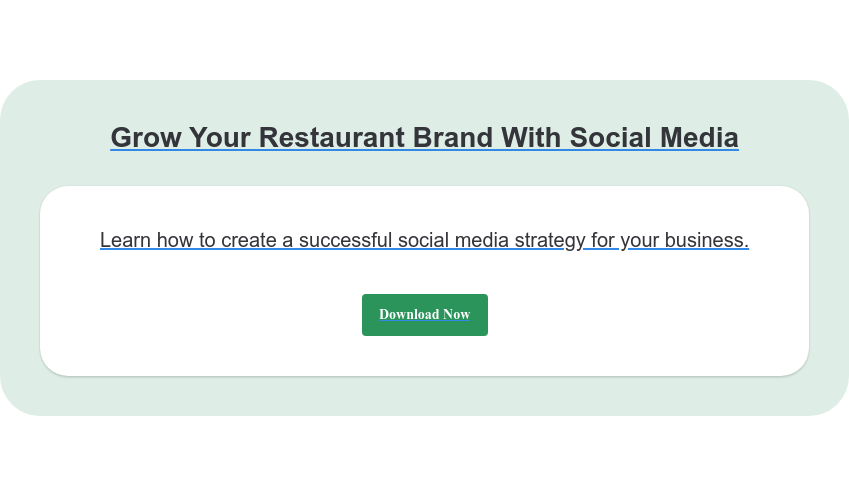
What makes a great restaurant social media marketing post?
To start off, it’s important to clarify that there is no such thing as the perfect restaurant social media post. However, a great restaurant’s social media post usually consists of a good quality or at least engaging image, along with specific trending hashtags (#) to help represent the restaurant. Then, it’s also important to tag the image. This will help to give your customers more insight into your restaurant, as well as give your business account and establishment free and valuable publicity. In addition, make sure your posts have:
-
Branding
-
A Call-to-action
-
Selection of relevant hashtags
-
Engaging content
Read on to discover more great tips & novel ideas on how you can create the ultimate restaurant social media posts:
As we mentioned before, the social media platforms local businesses use and the type of content it create are significantly dependent on the people it want to reach. Know your customers well enough find out what they are looking for when searching for a brand on social media and develop your strategy accordingly.
Digging deep into your CRM system is a great way of understanding your customers better and creating a clearer picture of your target audience. Data points like age, gender, breakdown of new vs repeat customers, and customer order history are just some of the factors from your CRM that can help you identify your restaurant’s top customers. Participating in local events can also boost your visibility and customer interaction.
Setting up your restaurant’s social media presence
Setting up a strong social media presence is essential for restaurants to succeed in the digital age. Here are some tips on how to set up your restaurant’s social media presence:
1. Create Proper Profiles
Creating proper social media profiles is the first step in setting up your restaurant’s social media presence. Here are some tips on how to create proper profiles:
-
Use a consistent brand name and logo across all social media platforms.
-
Use a high-quality profile picture and cover photo that represents your restaurant’s brand.
-
Fill out all the information fields on your social media profiles, including your restaurant’s name, address, phone number, and website.
-
Use relevant keywords in your social media profiles to help customers find your restaurant.
-
Use a consistent tone and language across all social media platforms to build a strong brand voice.
By following these tips, you can create a strong social media presence for your restaurant and start engaging with your customers. A well-crafted profile not only attracts potential customers but also helps in building trust and credibility for your restaurant.
2. Create high-quality content
Your posts on your social media page or business page represent your brand and are often the first encounter potential customers have with your restaurant. This makes the quality of your content one of the most important factors for social media marketing success. These platforms are overcrowded with brands - fun, engaging, and excellent content is what can help you stand out from your competition.
A well-rounded social media marketing strategy, tailored to seasonal trends and continually iterated, is essential to boost engagement and follower counts across social platforms.
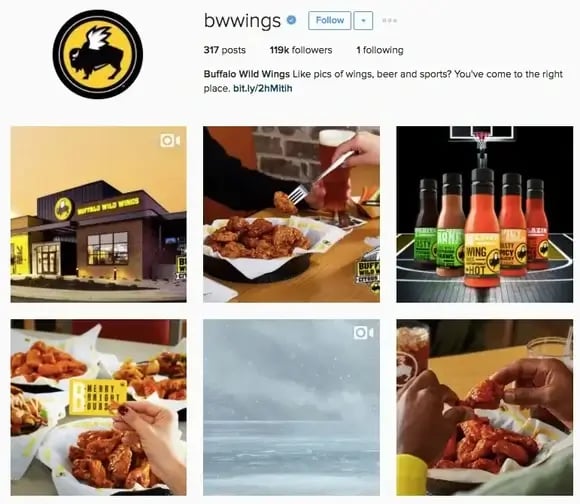
3. Be consistent
Diners tend to follow hundreds of brands on social media, and the way to catch their attention is by repeatedly reminding them about your brand by posting consistently. Use every style of content possible, like Instagram stories, reels, Facebook stories, etc. to make sure that you are able to reach as many people as possible.
To add to that, social media algorithms favor accounts that are active over those that aren’t. This means that consistent posting increases your chances of being visible to your customers. So be sure to include consistency in your marketing plan. Additionally, leveraging Instagram as a top social media platform can significantly enhance your restaurant's visibility and engagement.
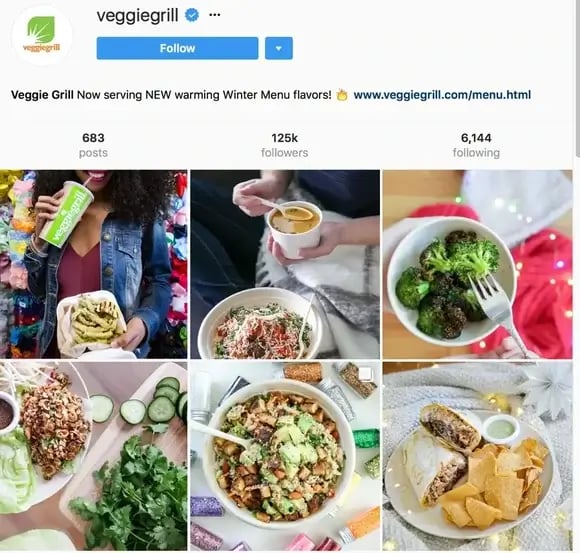
4. Capitalize on trends
New trends are popping up on social media every day. Give these topics your own twist to take advantage of the increased exposure that comes with them. However, don’t try to jump on every trend that comes your way. Choose the ones that align with your brand stand, style, and tone.
Incorporating these trends into your restaurant's social media strategy can significantly enhance visibility and engagement with both current and prospective customers.
5. Show your human side
It's easy to get lost in posting promotional and ‘sales-y' content about your restaurant. However, the best way to connect with your audience is by showing them that you're more than a business. Sharing about the people behind your restaurant, some BTS snippets, and other ‘non-promotional'' content helps people to see your brand as a relatable account and enables you to build stronger relationships with them.
6. Add a "book now" button
Some social media platforms like Instagram and Facebook allow restaurants to generate sales directly from their social pages by adding a “book now” button. All you need to do is be enlisted with one of the supporting reservation platforms, like Eat App, and you can allow people to reserve their table straight through your profile.
Learn how to enable direct bookings from your Facebook page here.
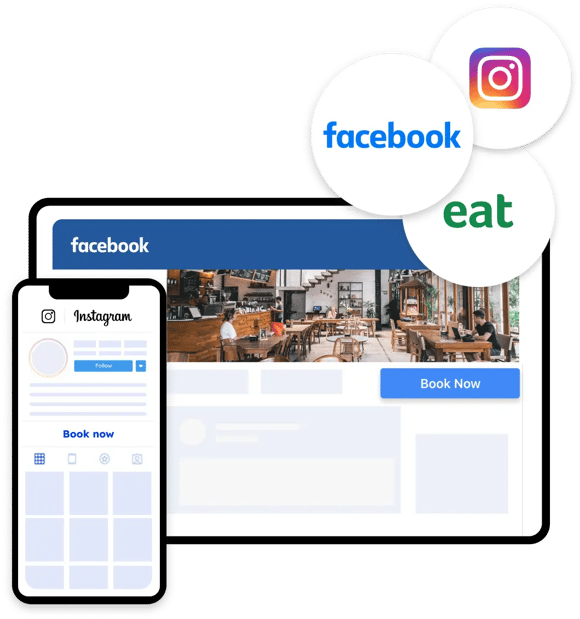
7. Engage with your audience
As social media is all about connecting people, engaging with your audience is crucial to improving your strategy. Communicating with them by asking questions, requesting feedback, and asking for suggestions helps create a two-way dialogue and makes people feel heard by your brand. For example, you can ask them to "fill in the blanks" - this will also up your engagement on your social media profile.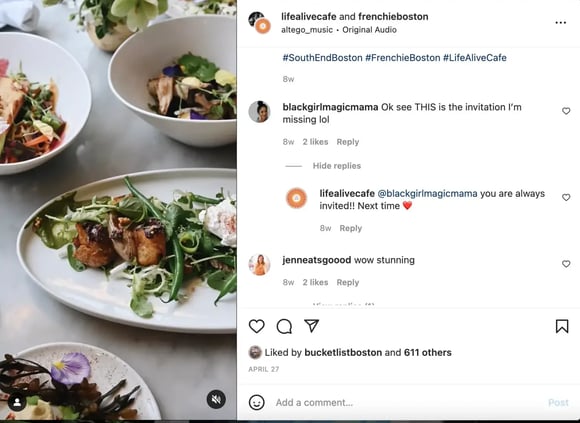
8. Analyze your strategy
Social media is constantly evolving. It's important to keep track of your performance and see how these changes are affecting your strategy, what's working and what's not working, and take action accordingly. Only upon analyzing will you be able to understand the type of content that works best for your restaurant.
9. Respond to reviews and feedback
Start by always telling the customer that you appreciate their feedback by saying "thank you." Make sure to also respond to any reviews or negative comments in a timely manner - as other customers might review how fast you deal with a query. Remember to always stay professional and courteous. Only apologize if appropriate and offer to take the conversation offline, especially if it's negative feedback. It's also important to remain genuine and authentic when dealing with your customers online.
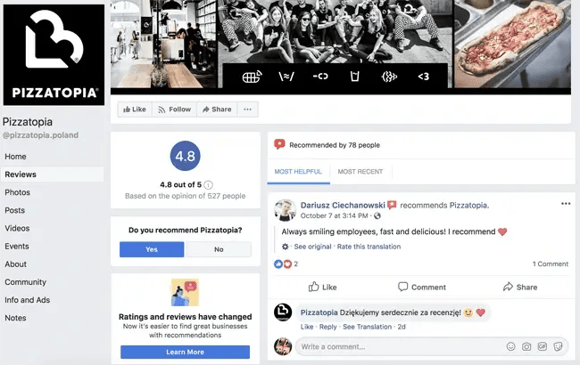
10. Utilize user-generated content
If you believe in your restaurant, and you feel confident that your food is top-class, why not encourage your customers to take a picture and share it on social media? It's also highly recommended to create an easy-to-use hashtag that your customers can use and remember when they post an image of your food or restaurant. Check-ins can also be very beneficial for your restaurant.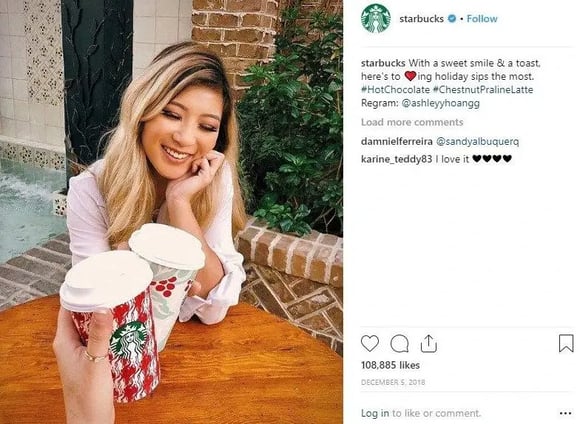
11. Use quality assets
It's considered essential when sharing videos or images of your restaurant on your social media platforms. Therefore, make sure to capture and share the overall ambiance, as well as the decor of your restaurant.
12. Highlight deals and promotions
Using social media to advertise your restaurant's events and deals is a great idea. To entice your followers to make a reservation or visit your restaurant, be sure to share details about impending events, such as live music nights or holiday specials, and convey a sense of urgency.
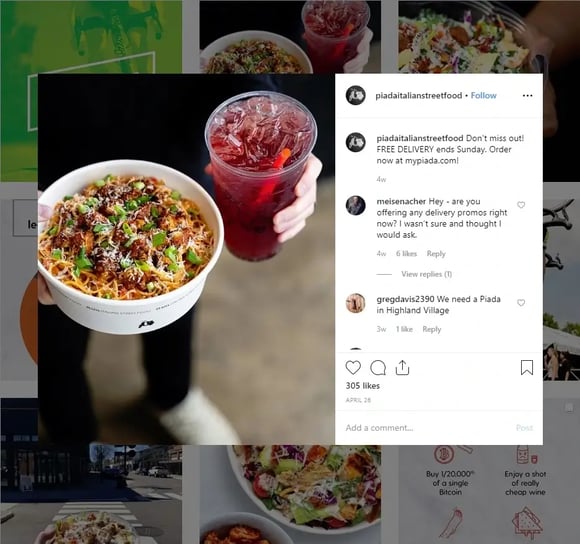
13. Use relevant hashtags and location tags
The best way to increase your social media following is through the use of hashtags and location tags, especially when you are first getting started. With the former, you can connect with people who are interested in a specific subject, while with the latter, you have a chance to show up in local social search results and be found by people in your area.
14. Post updated menus
Make sure to also include any new and exciting menu changes to your restaurant's social media channels. To take it a step further, call up a few reporters and food critics as well as foodie bloggers and influencers with sizable social media followings. Then, inform them that you are launching a new menu and provide them with incentives, such as free food and first tastings, to visit and try your new dishes.
15. Pose a question to engage with your audience
Sharing events from your restaurant with your followers on social media is just one aspect of the platform. It also involves paying attention to them. Using websites like Facebook, Twitter, and Instagram, you can have a two-way conversation with your audience. For prospective customers, Instagram stories' question and poll features are especially interesting and entertaining. Instead of just scrolling to the next story or down the page, asking questions can encourage followers to engage with your posts and with you.
16. Provide social media-only discounts
Providing special discounts to your social media followers can boost engagement and improve restaurant traffic. Customers who share a post or a story about your restaurant on social media can receive a discount on their meal or a free meal.
17. Advertise on social media
Advertising on social media can be a terrific method to promote your restaurant and reach a specific audience. On websites like Facebook or Instagram, you can build advertisements that are targeted at particular groups of people or interests. With a bit of ad spend you will be able to generate more users visiting your social media profiles. In other words, potential clients who might not be following your social media accounts can be reached this way.
18. Create a cohesive brand voice on your social media platforms
You spend time creating a fantastic restaurant interior. Show off on Instagram with an Instagram post on how amazing it is! To showcase your company through images, take into account your brand rules and stick to the same color palette.
19. Share images of your dishes
This one ought to be obvious, right? Of course, your restaurant should display the food it offers to clients! Yet, there is one thing you must remember: your photos must be really stunning. If your cuisine doesn't appear enticing, you run the risk of turning away clients. You may think about working with an expert photographer or you could use these straightforward guidelines for a DIY picture shoot. At the absolute least, spend some time investigating simple staging techniques, lighting setups, and other methods to make your food look its best.
20. Identify your audience
Use social media to find your customers and extend an invitation.
Individuals who are visiting other locations frequently post requests for food recommendations on social media. With social media monitoring, you as a business can spot these requests for recommendations on social media. Afterwards, you get in touch with that person and make your offer.
All you require is a project that is well-optimized and social media monitoring. Yes, you must compete with each and every customer on social media.
Examples of Successful Social Media Campaigns by Restaurants
1. Share kitchen BTS
Winnipeg bakery Jenna Rae Cakes gives its followers a look into their kitchen by sharing snippets of how they make their popular treats. These posts have proven very successful for the bakery, helping them gain thousands of views on its content.
2. Highlight your team
Miami-based bakers Sweet Studio introduced their staff with a fun and engaging Instagram reel that helped people connect with their brand in a personal way. One person commented, “I went to the bakery for the first time on Saturday and had a wonderful experience💗 The staff members and treats were fantastic! Thank you💞”. Seeing the team highlighted encouraged her to share her positive experience with others.
3. Run a competition
Dubai-based fine-dining restaurant Bombay Borough ran a Father's day giveaway on their social media that encouraged people to engage with the brand and receive an incentive in return. With this strategy, they capitalized on the existing Father's day trend and used it to boost their brand awareness.
4. Use a social media influencer
London-based Dumplings Legend restaurant collaborated with social media influencer @clerkenwellboyec1 to promote their limited edition dumpling pop-up. This allowed them to capitalize on Clerken's huge Instagram following and create awareness for their event.















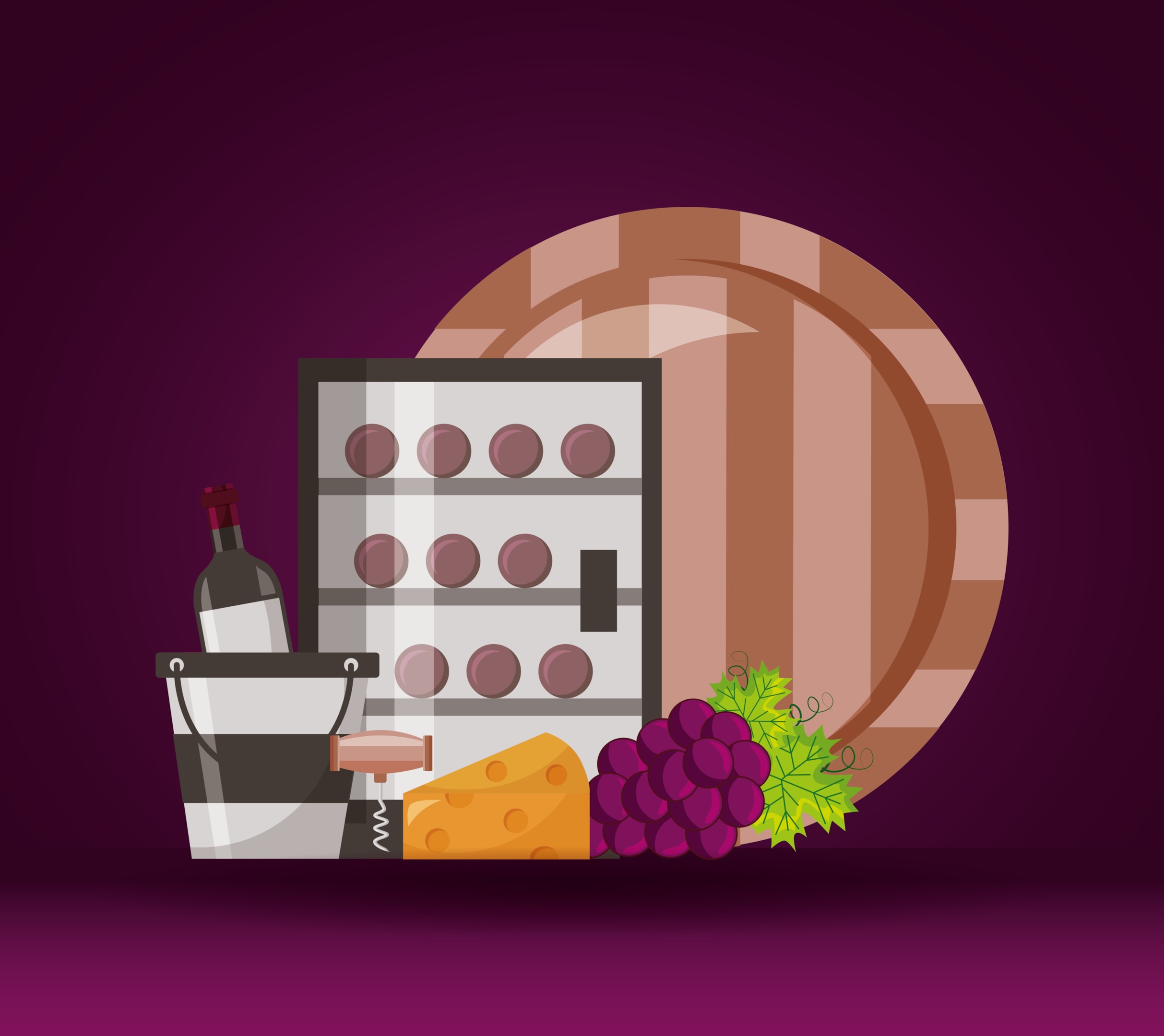
-1.png?width=1812&height=1072&name=TripAdvisor%20%26%20More%20Bookings%20(1)-1.png)
-2.png?width=1812&height=1072&name=Google%20Bookings%20(1)-2.png)


-1.png?width=200&name=TripAdvisor%20%26%20More%20Bookings%20(1)-1.png)
-2.png?width=200&name=Google%20Bookings%20(1)-2.png)
-1.png?width=200&name=Instagram%20Bookings%20(1)-1.png)
-1-png.webp?width=200&name=Facebook%20Integration%20Rectangle%20(1)-1-png.webp)







.webp?width=200&name=download%20(1).webp)
%20(1)-2.webp?width=200&name=Eat%20(34)%20(1)-2.webp)
%20(1)-2.webp?width=200&name=Eat%20(18)%20(1)-2.webp)




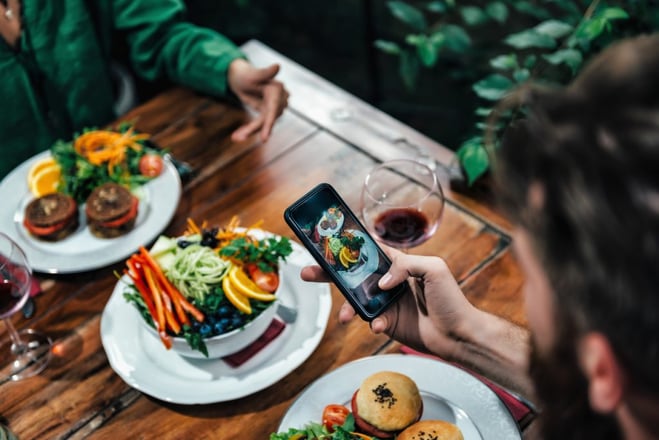
%20(1)-1.webp?width=314&height=175&name=Eat%20(45)%20(1)-1.webp)
%20(1).webp?width=314&height=175&name=Eat%20(53)%20(1).webp)
.webp?width=314&height=175&name=image19%20(1).webp)
%20(1).webp?width=314&height=175&name=Eat%20(66)%20(1).webp)


.webp?width=144&height=72&name=Eat%20App%20Logo%20(3).webp)